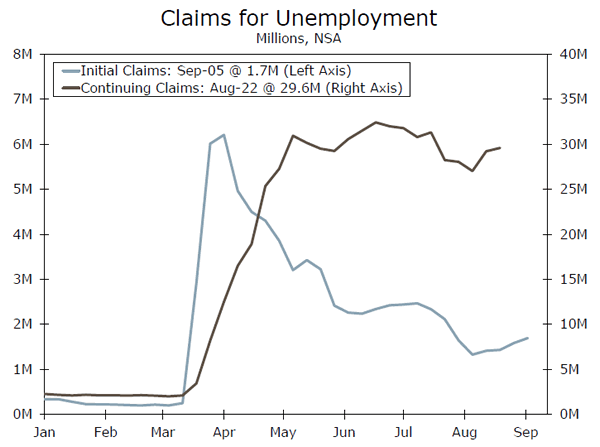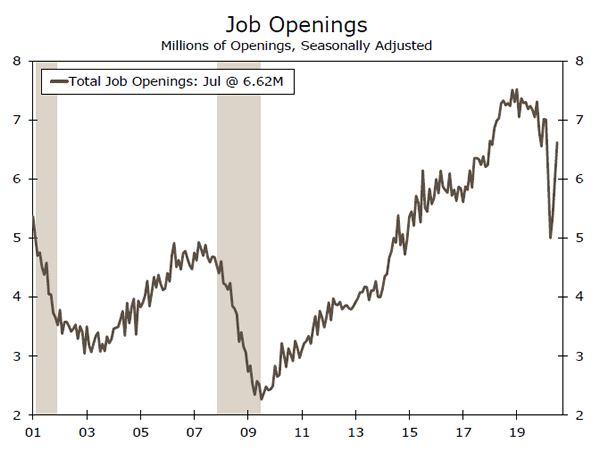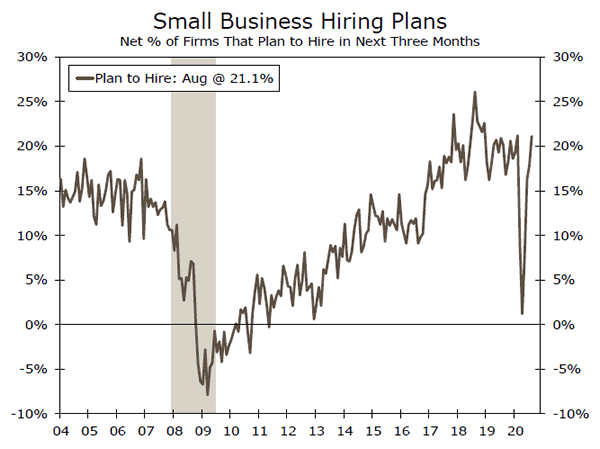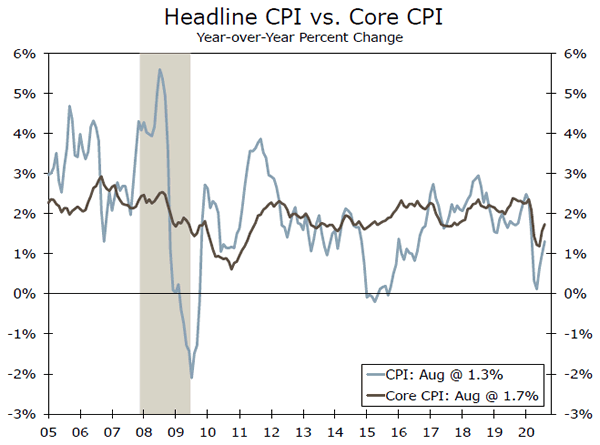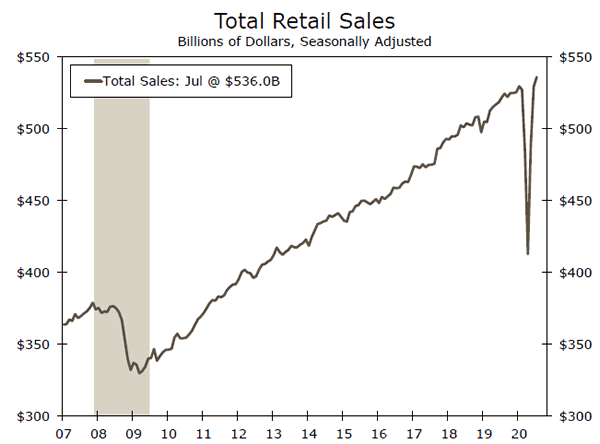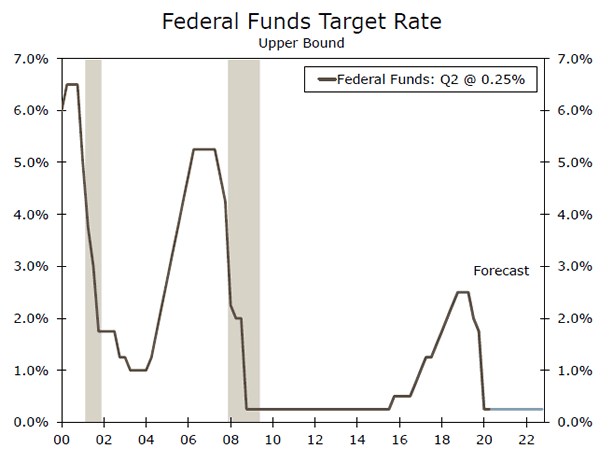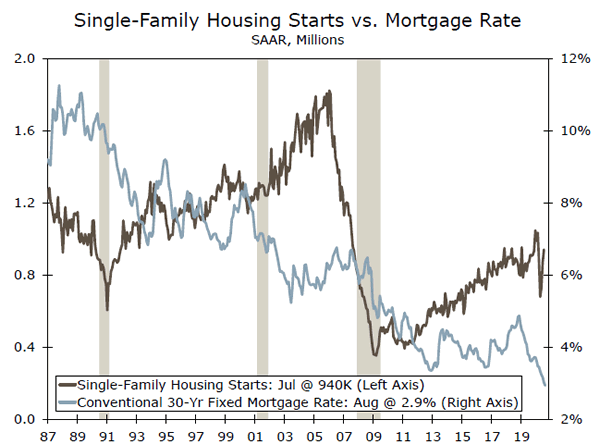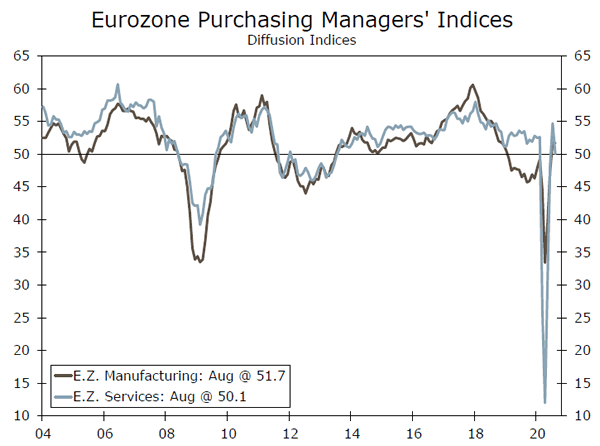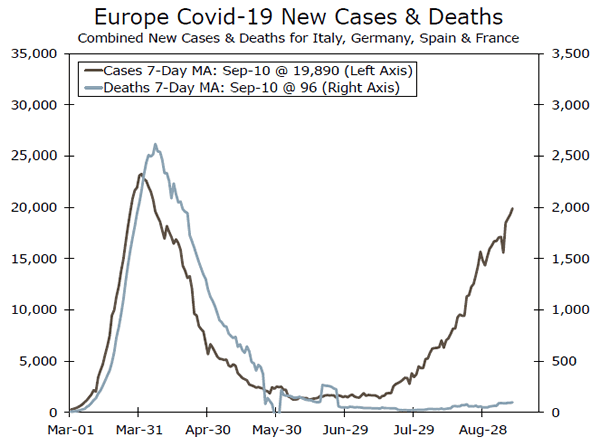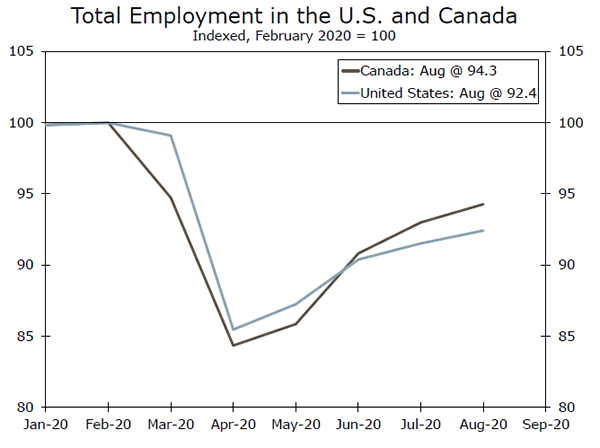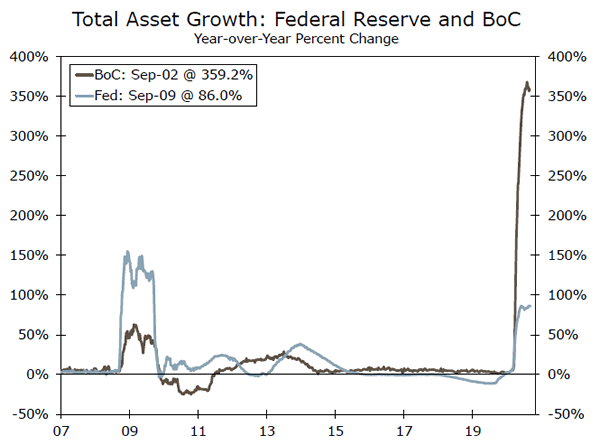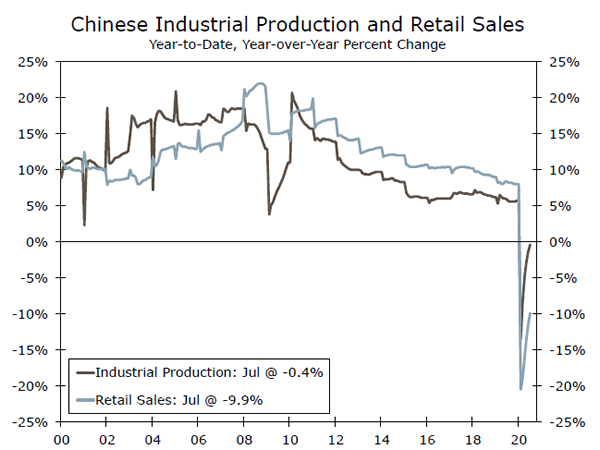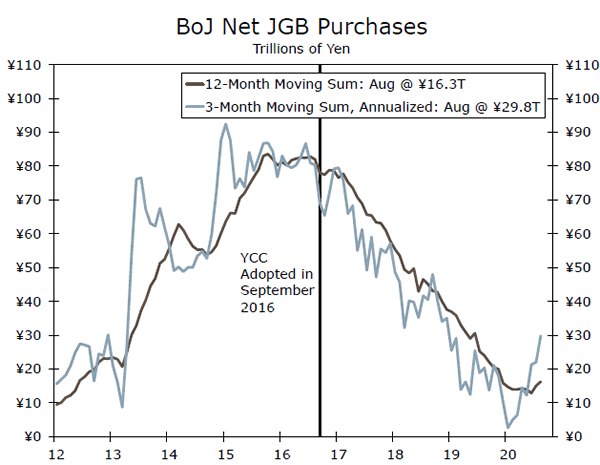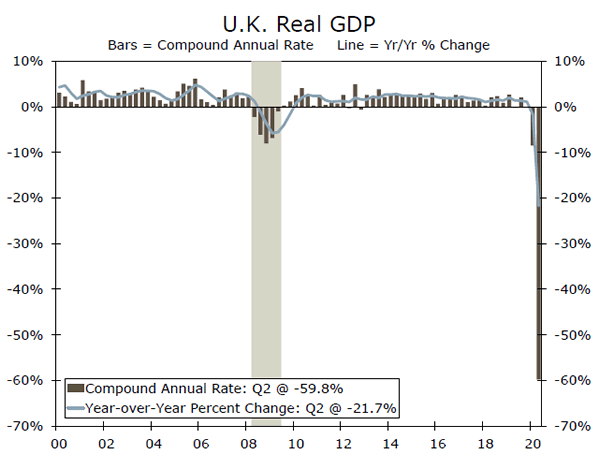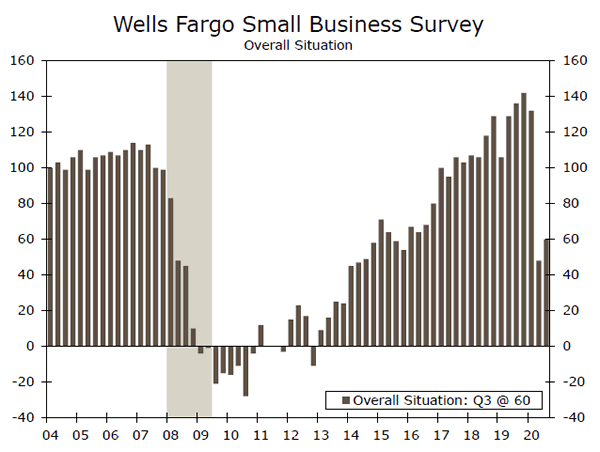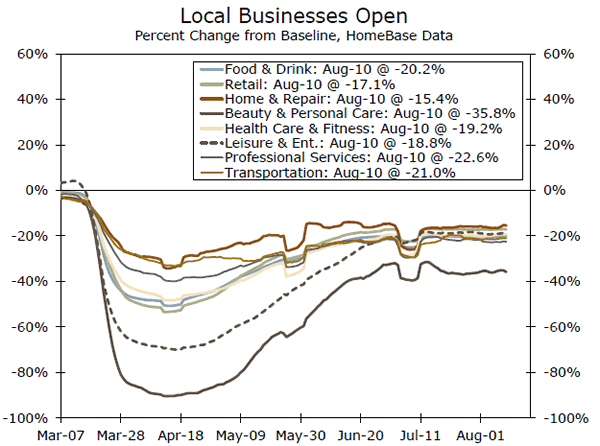U.S. Review
Labor Focus
- In the holiday-shortened week, analysts’ attention remained on the progress of the labor market. Recent jobless claims data remain stubbornly high and point to a slowing jobs rebound.
- Aside from claims, inflation data were also a highlight this week. Prices continued to pick up in August, but we expect it will be quite some time before inflation consistently exceeds 2%, preventing the Fed from lifting interest rates anytime soon.
- In our updated forecast this week, we released our initial estimates for 2022. At a high level, we expect the U.S. economy to grow above trend at 2.7% in 2022. For further details on our latest forecast, please see our Monthly Economic Outlook.
Labor Focus
The holiday-shortened week was rather light on the data front, and analysts’ attention remained on the progress of the labor market. The nonfarm payroll report last Friday showed employers added 1.37 million jobs last month, and the unemployment rate surprised to the upside with its slide to 8.4%. As such, we have updated our unemployment forecast and now look for the unemployment rate to be just below 6% by the end of next year (just above 6% previously) and below 5% by the end of 2022. This forecast suggests unemployment should be back at 2015 levels by the end of 2022—a steady improvement.
Although we look for the labor market to continue to improve, the rebound is expected to be gradual from here. The 1.37 million jobs added in August marked the fourth consecutive month of job gains, but was a step down from the prior three months, in which job growth averaged three million. Further, the latest jobless claims data suggest improvement in the labor market is slowing. Regular state level initial jobless claims were flat for the week ending September 5 at 884K, while claims for Pandemic Unemployment Assistance increased to 839K, resulting in a small up-tick in total initial claims. Continuing claims for unemployment insurance for all programs also rose to 29.6 million the last week in August. With the September nonfarm payroll survey conducted this week, it would likely take a marked decline in claims to notch a sizeable addition to employment in the next nonfarm payroll report.
Although there have been mixed signals on the labor market recently, the trajectory looks positive, in our view. The total pool of American’s receiving benefits has been slow to decline as more job losses have become permanent. But, over half of the unemployed still deem their job loss as temporary—which remains an encouraging sign in these trying times. Further job openings rose 617K positions in July to 6.6 million. The number of unemployed still outranked openings in July, however, with 2.5 workers for every job opening. If we consider the decline in the unemployed through August and keep the number of openings constant, that would suggest about two unemployed workers for every one job opening, which is consistent with 2014 levels. Openings are still high compared to the unemployment rate, which likely suggests a high degree of uncertainty among employers. Small business hiring conditions remain weak—8% of firms reported increasing employment during August, while 20% reported a decrease. Notably, however, hiring plans over the next three months have bounced back to their pre-virus level, which further supports continued improvement in the labor market. For now, as the virus drags on, hiring will likely continue to only gradually pick-up. So, while it’s important to acknowledge the rebound in the labor market is slowing, what’s more important is that it continues to improve.
In other news, we got a swath of fresh inflation data this week. The consumer price index (CPI) rose a solid 0.4% in August. Excluding food and energy prices, CPI also rose 0.4% from July, pushing the year-ago rate up to 1.7%. Although inflation continues to rise from its virus-related slump, COVID-19 is ultimately a demand shock, and still-relatively weak demand will prevent inflation from returning to the Fed’s 2% target for quite some time. Further, with the Fed now explicitly looking for inflation to run above 2% for a period under its new framework the expected tame rate of inflation should keep the FOMC from raising rates until at least 2023.
U.S. Outlook
Retail Sales • Wednesday
Retail sales rose 1.2% during July. This result was slightly below consensus estimates, but sales are now 1.2% above February’s peak level. The strength has been owed to spending on goods, which better accommodate social distancing (like cars and groceries), while closecontact services spending has been much weaker. During July, control group sales increased an even better 1.4%. Control sales are used as an input into the personal consumption expenditures (PCE) component of GDP. Thus, we should see a significant bounce in both PCE and overall real GDP in Q3.
In terms of topline retail sales, the quick bounce-back was also helped by fiscal relief measures which may soon run dry. Absent any new stimulus, spending may cool in the second half of the year. That said, the saving rate has soared recently and remains highly elevated, which should help support sales over the coming months as fiscal aid begins to fade.
Previous: 1.2% Wells Fargo: 0.9% Consensus: 1.0% (Month-over-Month)
FOMC Rate Decision • Wednesday
At the (virtual) Jackson Hole Symposium, Chair Powell announced a shift in how the Fed will conduct monetary policy. In short, the FOMC would adopt a flexible average inflation targeting regime which will aim to “achieve inflation that averages 2% over time.” Powell also revealed that the FOMC will take a more dovish view of labor market developments. The upcoming September 15-16 FOMC meeting will be the first official meeting since these changes.
Fed officials will also release the first update to the fed funds dot plot and Summary of Economic Projections (SEP) since June. Given labor markets are still weak, and there is little sign of inflation, we expect no change to the current fed funds target of 0.0%-0.25% as an outcome on Wednesday. Furthermore, the vast majority of participants will likely indicate that a fed funds rate anchored to zero will still be appropriate for several years to come.
Previous: 0.25% Wells Fargo: 0.25% Consensus: 0.25% (Upper Bound)
Housing Starts • Thursday
Housing starts jumped 22.6% in July, blowing past even the most optimistic expectations. Single-family starts increased a solid 8.2%, while multifamily starts surged 58.4%. This massive rise also follows a sharp upturn in homebuilder confidence, which similarly soared well-past expectations. The recent strength is due to a number of factors. Mortgage rates have declined to record lows, currently sitting below 3%. On top of this, there has been a shift in housing preferences away from dense urban areas to larger spaces in the suburbs that can more easily accommodate home offices and gyms.
Given inventories remain relatively low, single family construction should continue to trend higher. By contrast, multifamily development may start to moderate, as vacancy rates continue to spike in many large apartment markets. Overall, we don’t expect a repeat of July’s robust gain, but the number of housing starts should still remain quite strong.
Previous: 1,496K Wells Fargo: 1,437K Consensus: 1,480K (SAAR)
Global Review
ECB and BoC Relatively Quiet This Week
- It was a relatively quiet meeting for policymakers at the European Central Bank (ECB) this week. The policy statement was almost a verbatim copy of July’s and President Lagarde mainly toed the line in her comments.
- We remain constructive on the Eurozone recovery, but we will be watching the recent COVID-19 outbreak and the government responses very closely in the weeks ahead.
- The Bank of Canada (BoC) also met this week, and like the ECB it mostly left monetary policy unchanged. The central bank noted that the “bounce-back in activity in the third quarter looks to be faster than anticipated in July.”
ECB and BoC Relatively Quiet This Week
It was a relatively quiet meeting for policymakers at the European Central Bank (ECB) this week. The policy statement was almost a verbatim copy of July’s and President Lagarde mainly toed the line in her comments. Over the past couple meetings, the ECB has adopted a wait-and-see approach that is akin to what the Federal Reserve has done in the United States. The ECB’s policy rates are already firmly in negative territory, and sovereign bond purchases have been chugging along at a solid clip. The ECB could push even deeper into unchartered territory, but the potential marginal benefits do not appear to be obviously larger than the potential marginal costs. Borrowing costs across the continent are already strikingly low. In Italy, one of the most fiscally troubled countries in the bloc, 10-year government bond yields are around just 1.0%.
The Eurozone’s economic recovery has been progressing nicely over the past few months, and our forecast for Eurozone real GDP growth next year has been drifting higher. In addition to stronger economic data, positive news on the fiscal policy front have led to more optimism. The EU-wide agreement to finance a €750 billion recovery fund signals that fiscal policy cooperation across the bloc is a potential tailwind to the recovery. Most recently, France unveiled a €100B, four-year stimulus package to support the recovery and maintain the momentum in the coming years. Against this backdrop, the euro has strengthened about 10% against the U.S. dollar since mid-May.
That said, there have been some recent signs of cracks in the Eurozone recovery. Eurozone real retail sales declined in July, the first monthly decline since April, and the August services PMI fell by 4.2 points to 50.5 (see chart on front page). New COVID-19 cases have been rising been rising across Europe since the end of July (top chart), with the upward trending looking more and more like the one that occurred in the United States starting in mid-July. We remain constructive on the Eurozone recovery, but we will be watching the recent COVID outbreak and the government responses very closely in the weeks ahead.
The Bank of Canada (BoC) also met this week, and like the ECB it mostly left monetary policy unchanged. The BoC’s main policy rates were left unchanged, and its quantitative easing program continues to plug along. The central bank noted that the “bounceback in activity in the third quarter looks to be faster than anticipated in July.” About 63% of the jobs lost in Canada in March and April have been recovered, a better outcome than the United States, which has recovered about 48% of the lost jobs over that period (middle chart).
As aggressive as the Federal Reserve has been, the BoC has matched its southern counterpart stride for stride. The BoC’s total assets have risen a stunning 359% year-over-year, in contrast to 87% for the Federal Reserve (bottom chart). Admittedly, some of this is due to the lower starting point for the BoC’s balance sheet. But extraordinarily easy monetary policy, sizable fiscal stimulus and low public debt levels coming into the pandemic, the Canadian economy is positioned well for a continued economic recovery into 2021.
Global Outlook
China Industrial Production • Monday
The Chinese economy continues to claw its way out of the deep hole that opened in the first quarter. The Chinese factory sector has mostly recouped all of its losses; through July, year-to-date industrial output is more or less flat to 2019. Fixed assets and property investment are also about flat compared to last year. Chinese retail sales have been much slower to comeback and were still down 10.0% year-to-date. This marks an interesting contrast with the United States. Through June, the latest data available, industrial production in the U.S. was down about 8.0% year-to-date, but real retail sales were actually up 1.0% over the same period.
Our forecast for Chinese real GDP growth in 2020 has been drifting higher over the past few months and is currently the highest it has been since March 11. Next week’s industrial production, retail sales and investment data for August will help us determine if additional upward revisions are warranted.
Previous: -0.4% Consensus: 0.2% (Year-to-Date, Year-over-Year)
Bank of Japan Meeting • Thursday
Despite a less severe lockdown, the Japanese economy has taken a nosedive like many of its developed market peers. On a year-overyear basis, real GDP was down 9.9% in Q2-2020, a bit more than the 9.1% contraction in the United States, but still less than the 14.7% collapse in the Eurozone. Japanese economic data with a monthly frequency suggest a rebound began to take hold towards the end of the second quarter, but a sizable output gap is likely to remain for some time, in our view.
At recent meetings, the Bank of Japan (BoJ) has largely kept key policy levers unchanged. BoJ purchases of sovereign bonds have ticked up a bit, but they are still running well short of the pace seen in the United States, Europe and elsewhere, as market forces have largely kept the 10-year government bond yield tethered near the central bank’s target of 0%. We do not expect any major policy moves from the BoJ next week.
Previous: -0.10% Wells Fargo: -0.10% Consensus: -0.10% (Policy Balance Rate)
Bank of England Meeting • Thursday
The United Kingdom’s economy was crushed through the first half of the year. Real GDP declined 21.7% year-over-year in Q2, even more than Italy (-17.7%) and roughly on par with Spain (-22.1%). Household consumption is a major portion of the U.K. economy, accounting for about 65% of GDP, and the strict lockdown in place for most of Q2 helped drive a 25.2% year-over-year decline in household consumption.
To date, the Bank of England has cut its main policy rate to 0.10%, and increased its asset purchases by £218 billion, driven by £210 billion of sovereign bonds and £8 billion of investment grade corporate bonds. We doubt the Bank of England will take its policy rate into negative territory anytime soon, but we do believe another £100 billion of asset purchases will be announced in Q4. Thus, it would not surprise us if the BoE uses its meeting next week to start telegraphing that such a move is coming later in the year.
Previous: 0.10% Wells Fargo: 0.10% Consensus: 0.10% (Bank Rate)
Point of View
Interest Rate Watch
Outlook for FOMC Meeting
The Federal Open Market Committee (FOMC) will meet next week for the first time since Chair Powell outlined the Fed’s new policy strategy at the Jackson Hole Symposium on August 27. Specifically, the FOMC modified its longer-run inflation goal from 2% to an inflation rate “that averages 2 percent over time.” The committee made this change because the Fed has had little success in achieving 2% inflation on a sustained basis over the past ten years or so (top chart). In addition, the FOMC will now make policy changes based on “assessments of the shortfalls of employment from its maximum level” rather than “deviations from its maximum level.”
As we wrote in a recent report, we look for few concrete policy changes at next week’s meeting. That said, we expect that the committee will communicate its intentions regarding the outlook for monetary policy. In that regard, 15 of the 17 committee members expressed in June that they thought it would be appropriate to keep the target range for the fed funds rate between 0.00% and 0.25% through the end of 2022 (middle chart). In the September update to the so-called “dot plot,” we look for all 17 FOMC members to now think it appropriate to keep rates unchanged through the end of 2022. With the committee adding 2023 to the dot plot at this meeting, we expect that most members will signal that they do not plan at this time to change rates through the end of that year as well. In other words, short-term rates likely will remain near 0% for the foreseeable future.
On a monthly basis, the Federal Reserve has been buying $80 billion worth of Treasury securities and $40 billion worth of mortgage-backed securities (MBS), which has led to a significant increase in the size of its balance sheet (bottom chart). Although we do not expect the FOMC will announce a change in the pace of asset purchases at this meeting, a heftier monthly pace of purchases becomes more likely in coming months if inflation shows little signs of moving toward 2%. In other word, long-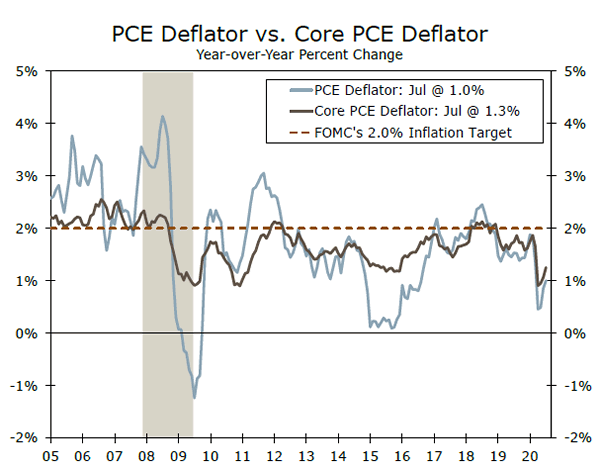
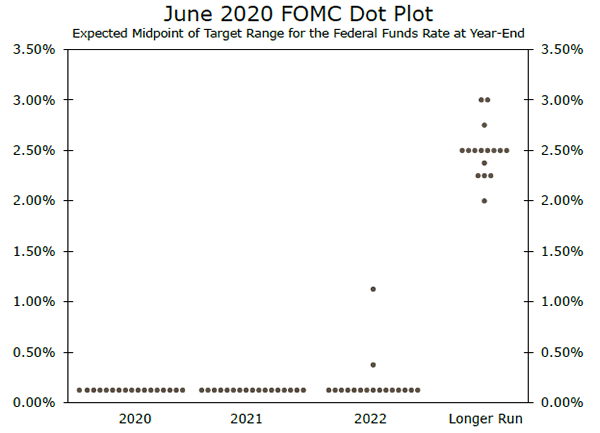
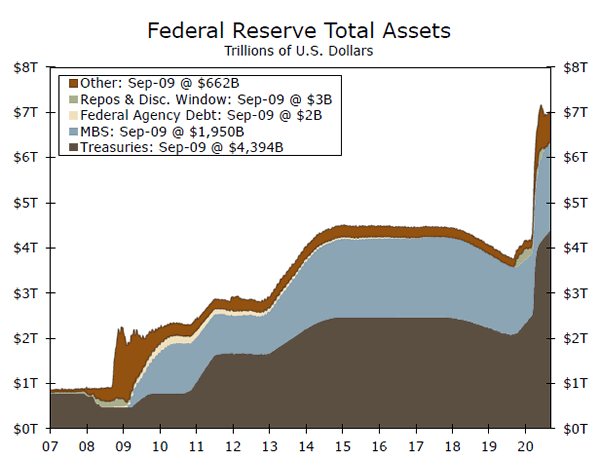 term interest rates likely will remain extraordinarily low for quite some time.
term interest rates likely will remain extraordinarily low for quite some time.
Credit Market Insights
Consumer Credit Increases in July
Consumers entered the crisis with relatively healthy balance sheets. Household debt as a share of disposable income had declined significantly, debt servicing costs were manageable and delinquencies across debt types were low. Yet, as expected, lending standards for consumer loans sharply tightened at the onset of the pandemic in reaction to the suffering jobs market. At the same time, borrowing needs were, at least in part, reduced by federal stimulus efforts and the incredibly uncertain outlook.
Consumer credit thus tumbled $95.8B between its February pre-virus peak and its May low. More recently, however, demand for credit has picked up. Borrowing increased $12.2B in July following an $11.4B gain in June, leaving total consumer credit just 1.7% below its February peak. The rebound came entirely from non-revolving credit which is mostly comprised of auto and student loans. The latest personal spending data show strength in auto expenditures which may be helping to push this category higher. Revolving credit, on the other hand, decreased for the fifth consecutive month. Weekly updates from the Fed suggest that revolving plans have fallen even further in August, possibly reflecting high personal savings or consumers’ unwillingness to take on additional credit card debt during this period of uncertainty. But, with most household stimulus having expired at the end of July, consumers may have to rely more on credit in the near-term.
Topic of the Week
Small Business Owners Show Resilience
Two widely followed measures of small business confidence were released this week: the monthly National Federation of Independent Business (NFIB) Small Business Optimism Index and the quarterly Wells Fargo/Gallup Small Business Index Survey. Both surveys showed increases in overall confidence, although they also remain well below the highs hit late last year.
Small business has been near the eye of the economic storm spawned by efforts to contain COVID-19. Businesses that require a high degree of customer interactions, such as restaurants, bars, hotels, entertainment venues, fitness studios and medical & dental practices have been among the hardest hit sectors. Many businesses have only been able to partially re-open and business has been slow to return, as many consumers remain reluctant to re-engage in economic behavior that might put them at risk for contracting the virus. Some businesses, including those tied to homebuilding and home renovations, have been less impacted.
The travails of small businesses are easily seen in the confidence measures, which plummeted as the efforts to contain the virus effectively shut down much of the economy. Relief programs, such as the Paycheck Protection Program (PPP), sparked a rebound in small business confidence late this spring, with most of the improvement stemming from the future expectations components. The PPP may also be behind gains in the employment components of these surveys. This reflects efforts by small businesses to comply with the program’s covenants that will convert their loans into grants if certain hiring benchmarks are met.
Recent gains in small business confidence likely reflect the improvement in overall economic activity that occurred as the spread of the virus waned. Data from HomeBase showed a steady rebound in the share of small businesses open for business through early June, but then leveled off as the number of new infections rose across the southern half of the United States.




